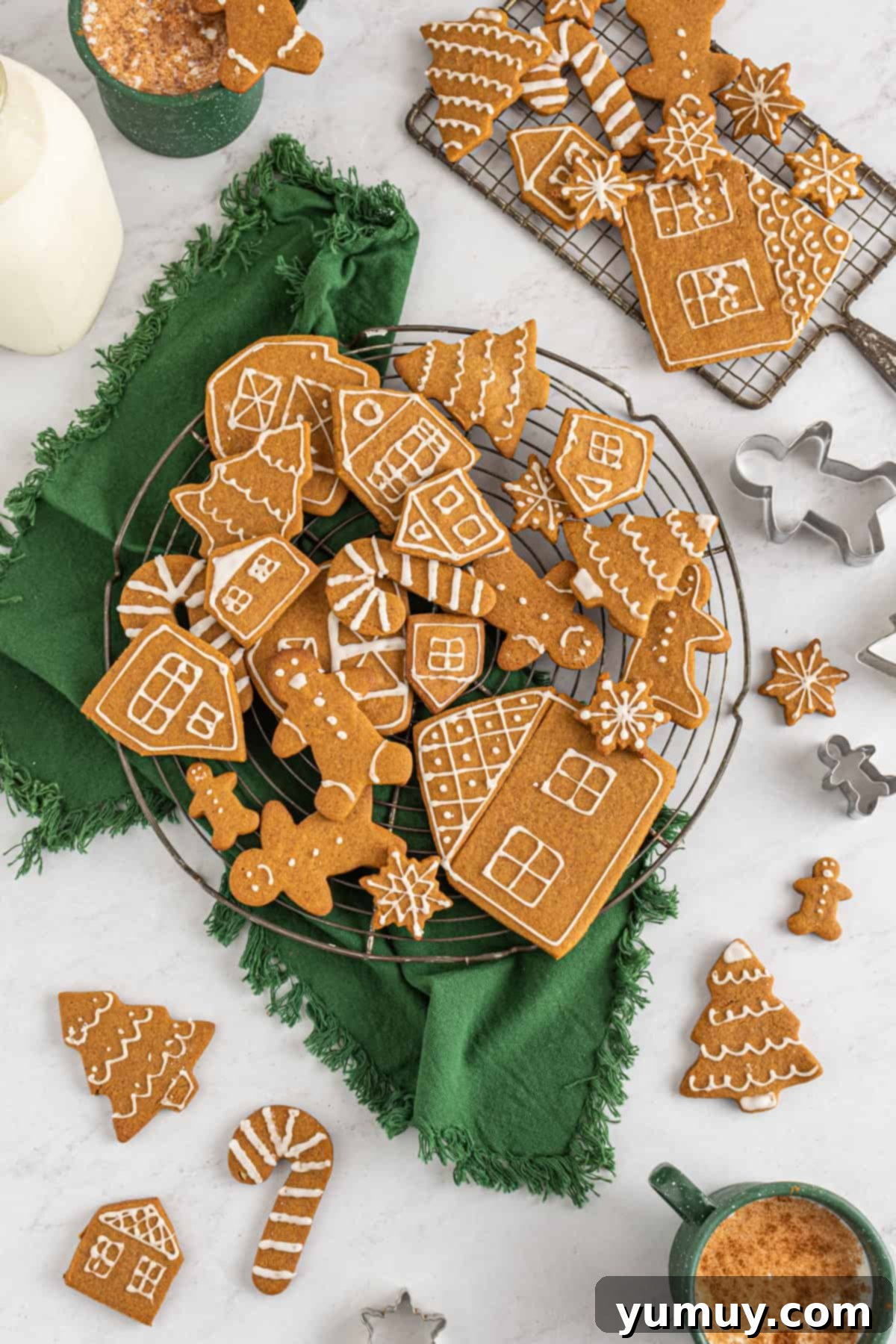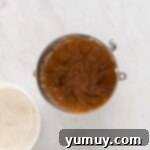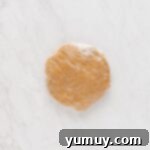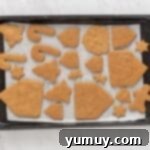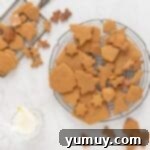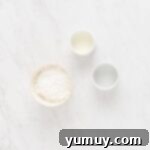The Ultimate Easy Gingerbread Cookie Recipe: Your Guide to Festive Holiday Baking
The holiday season simply isn’t complete without the comforting aroma and delightful taste of homemade gingerbread cookies. This ultimate easy gingerbread cookie recipe promises to bring warmth and joy to your kitchen, filling your home with the quintessential scents of ginger, cinnamon, and molasses. Forget complicated techniques and endless searching; this recipe simplifies the process, making it accessible for bakers of all skill levels. With just a handful of staple ingredients, you’ll create a batch of festive treats that are crisp on the outside, perfectly chewy within, and ready for all your holiday decorating dreams.

There’s something truly magical about gingerbread cookies. Their rich, spicy flavor evokes cherished winter memories, while their sturdy yet tender texture makes them ideal for both delightful snacking and creative construction. Whether you’re cutting out intricate gingerbread men and stars, crafting edible ornaments, or embarking on a grand gingerbread house project, this no-spread recipe ensures your shapes hold perfectly, bake beautifully, and taste absolutely incredible. These aren’t just cookies; they’re an edible tradition, a symbol of holiday cheer, and a delicious way to celebrate the most wonderful time of the year.
Why This Is Your Go-To Gingerbread Cookie Recipe
This easy gingerbread cookie recipe is designed for both novice and experienced bakers, offering a hassle-free path to holiday perfection:
- Effortless Preparation: This recipe calls for simple, accessible ingredients and straightforward steps, making holiday baking a breeze and enjoyable for the whole family.
- Perfect Texture Every Time: Enjoy cookies with wonderfully crisp edges that give way to a soft, slightly chewy center – a texture universally loved and addictive.
- Rich & Authentic Flavor: A harmonious blend of fragrant molasses and warm, aromatic spices delivers that classic, irresistible gingerbread taste that defines the holiday season.
- No-Spread Guarantee: Our carefully balanced recipe ensures your meticulously cut-out shapes remain sharp and defined during baking, making them perfect for intricate decorating or building.
- Versatile for All Occasions: These cookies are not only fantastic for gifting, party platters, and festive cookie exchanges, but their robust structure also makes them ideal for assembling sturdy gingerbread houses or edible ornaments.
- Freezer-Friendly: Both the baked cookies and the raw dough can be frozen, allowing you to prepare ahead and enjoy fresh gingerbread treats anytime.
Essential Ingredients for Your Perfect Gingerbread Cookies
Crafting the perfect gingerbread cookie starts with understanding the role each ingredient plays in creating that signature flavor and texture. Here’s a closer look at what you’ll need and why:
- All-Purpose Flour: The fundamental building block of our cookies, providing the necessary structure and body. Accurate measurement of flour is crucial for preventing spread and maintaining the integrity of your cut-out shapes. For the most consistent results, measuring by weight (approximately 320g for 2⅔ cups) is highly recommended.
- Unsalted Butter (Room Temperature): Butter is key for adding moisture, richness, and an incredible depth of flavor to these cookies. Ensuring your butter is properly softened to room temperature is vital for successful creaming with the sugars, which incorporates air and contributes to a lighter, more tender cookie texture. Our detailed recipe card specifies salted butter; if you opt for unsalted butter, remember to add a pinch of fine sea salt (about ¼ teaspoon) to balance the sweetness.
- Brown Sugar & Granulated Sugar: This combination of sugars is carefully chosen to achieve the ideal balance of sweetness and chewiness. Brown sugar, with its inherent moisture and slight molasses content, contributes a deeper, caramel-like note and enhances the cookies’ tenderness. Granulated sugar provides the necessary structure and contributes to the crispness of the cookie edges.
- Molasses: This is unequivocally the heart and soul of classic gingerbread flavor. I highly recommend using dark unsulphured molasses for a deep, rich, robust, and authentically festive taste. It’s imperative to avoid blackstrap molasses, as its flavor profile is significantly stronger and can easily overpower the other spices, often resulting in an unpleasantly bitter cookie. Beyond flavor, molasses adds essential moisture and contributes to the cookies’ beautiful, characteristic dark brown hue.
- Large Egg & Egg Yolk: Eggs serve as vital binding agents, providing structure and cohesion to the cookie dough. The addition of an extra large egg yolk specifically contributes extra richness and helps to create that highly desirable chewy texture, ensuring the cookies remain tender rather than crumbly.
- Pure Vanilla Extract: A generous splash of high-quality vanilla extract significantly enhances and rounds out all the other flavors present in the cookies. It adds a subtle layer of warmth and complexity that beautifully complements the bold spice profile. For an even richer aroma and taste, consider using homemade vanilla extract.
- Warm Spices (Ground Ginger, Cinnamon, Nutmeg, Cloves): These are the undisputed stars of the show, defining the gingerbread experience. Ground ginger provides that characteristic zesty warmth and gentle heat. Cinnamon offers a sweet, woody aroma and a comforting warmth. Nutmeg adds a subtle, almost creamy complexity, while a judicious hint of ground cloves brings a deep, intensely aromatic, and slightly pungent note. Feel free to adjust the amount of cloves to your personal preference, as it is quite a potent spice.
- Baking Powder: As a chemical leavening agent, baking powder plays a crucial role in helping the cookies rise ever so slightly in the oven, contributing to their tender, cake-like crumb.
- Salt: A small but mighty ingredient, salt is absolutely vital. It doesn’t just add flavor; it balances the sweetness of the sugars and molasses, and significantly enhances all the wonderful aromatic notes of the spices. Always use a good quality kosher or sea salt.
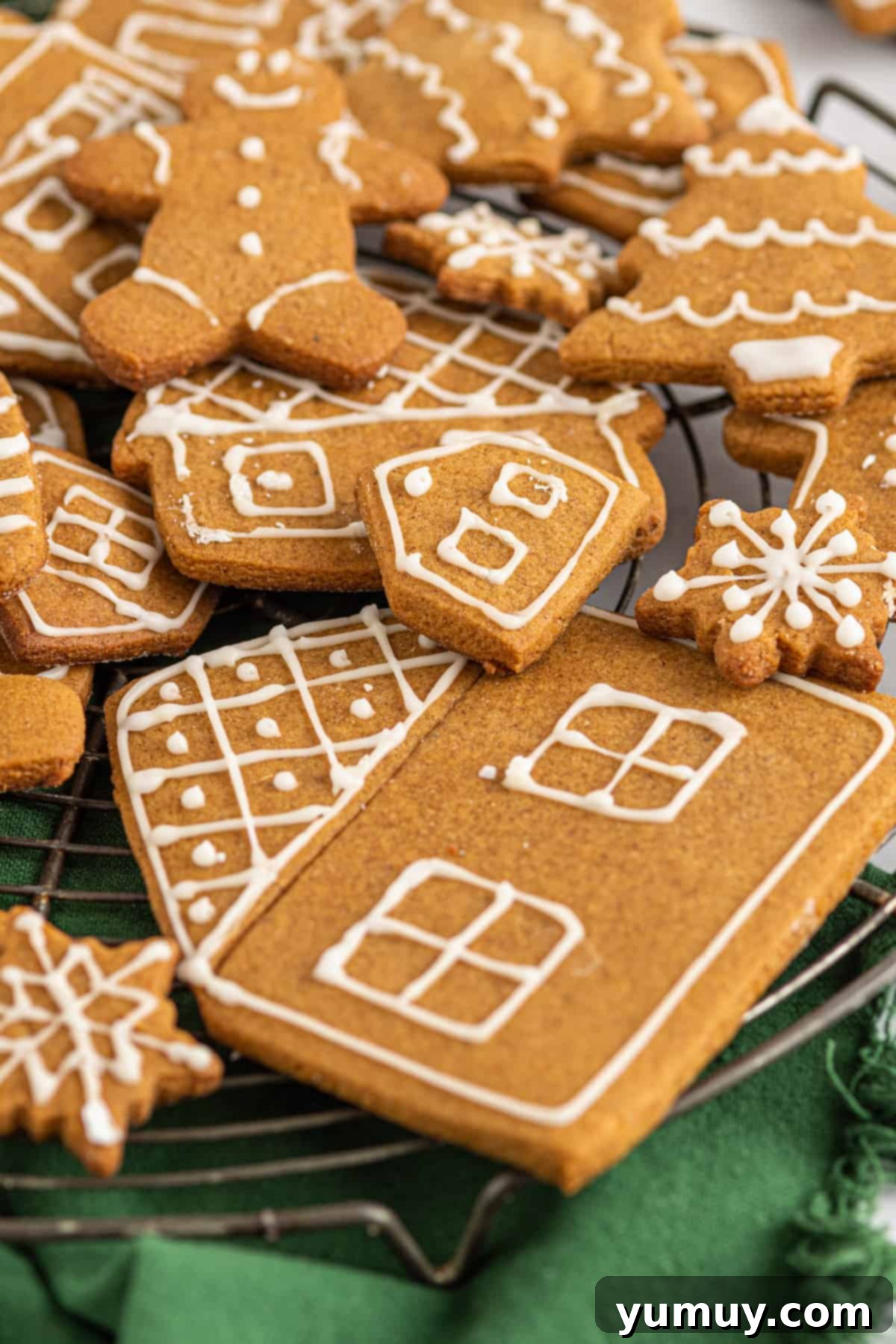
How to Store Your Gingerbread Creations: Keeping Them Fresh
Proper storage is essential to keep your gingerbread cookies fresh, flavorful, and perfectly textured throughout the holiday season and beyond. Follow these guidelines for optimal results:
- Room Temperature Storage (Baked Cookies): Once baked and completely cooled, store your undecorated gingerbread cookies in an airtight container at room temperature for up to 3-5 days. To help maintain their softness, you can place a slice of fresh bread in the container with the cookies, replacing the bread every couple of days as it dries out.
- Refrigerator Storage (Iced Cookies): While not strictly necessary for short-term storage, iced gingerbread cookies can be kept in an airtight container in the refrigerator for up to 1 week. It’s crucial to ensure that any royal icing or other decorations are fully set and hardened before stacking the cookies to prevent sticking or smudging.
- Freezing Baked Cookies: For longer enjoyment, cooled, undecorated gingerbread cookies freeze beautifully. Arrange them in a single layer on a baking sheet and freeze until they are solid (this prevents them from sticking together). Once frozen, transfer the cookies to a freezer-safe airtight container or a heavy-duty freezer bag, separating layers with parchment paper. They can be stored in the freezer for up to 1 month. Thaw the cookies at room temperature for a few hours before decorating and serving.
- Freezing Unbaked Dough (Make-Ahead Magic): This is an excellent strategy for holiday meal prep! Prepare the gingerbread dough as instructed, then wrap it tightly in at least two layers of plastic wrap, pressing out any air. For extra protection, place the plastic-wrapped dough into a freezer-safe zip-top bag. The dough can be frozen for up to 3 months. When you’re ready to bake, transfer the frozen dough to the refrigerator and allow it to thaw overnight. Once thawed, proceed with rolling out and baking the cookies as directed in the recipe. This method ensures you can enjoy freshly baked gingerbread whenever the craving strikes, with minimal effort on baking day!
Expert Tips for Gingerbread Cookie Perfection
Achieving the perfect batch of gingerbread cookies is easy with these insider tips and tricks:
- Chill the Dough Thoroughly: Do not underestimate or skip the chilling step! This is absolutely crucial for preventing your cookies from spreading excessively in the oven, ensuring they maintain their crisp, defined edges and soft centers. A well-chilled dough is also significantly easier to roll out evenly and cut into precise shapes without sticking or deforming. Aim for at least one hour, or even overnight for the best results.
- Flour Your Surface (Judiciously!): Lightly dust your work surface and rolling pin with all-purpose flour to prevent the dough from sticking. However, be mindful not to use too much flour, as excessive flour can be incorporated into the dough, making your cookies dry, tough, and crumbly. Keep a clean, soft pastry brush handy to gently dust off any excess flour from your cut-out shapes before baking.
- Roll Evenly for Consistent Baking: Aim for a consistent thickness of about ¼-inch when rolling out the dough. This uniformity is key to ensuring that all your cookies bake evenly at the same rate, preventing some from being underbaked while others become overdone. Thinner cookies will naturally be crispier, while slightly thicker ones will yield a chewier result.
- Maximize Your Cuts and Minimize Re-rolls: Arrange your cookie cutters as closely as possible on the rolled-out dough without overlapping to maximize the number of cookies you get from each pass. The less you re-roll the dough scraps, the more tender your subsequent batches of cookies will be, as repeated handling can develop gluten and toughen the dough. Try to re-roll scraps only once or twice at most.
- Know When They’re Done: Gingerbread cookies are typically finished baking when their edges appear firm and very lightly golden brown, and the centers look set. They might still feel slightly soft to the touch in the middle when you first remove them from the oven; this is perfectly normal, as they will continue to firm up as they cool on the baking sheet. Overbaking is the enemy of a tender gingerbread cookie, leading to a dry, brittle texture.
- Cool Completely Before Decorating: Patience is a virtue, especially when it comes to decorating! Ensure your cookies are completely cool to the touch before attempting to apply any icing, frosting, or other decorations. Warm cookies will cause icing to melt, bleed, or run, leading to messy and unappealing results.
- Get Creative with Decorating: The blank canvas of a gingerbread cookie is begging for your artistic touch! For intricate, hard-set designs and fine lines, royal icing is your best friend. Alternatively, opt for a softer, creamy topping like a brown sugar frosting for a different texture and flavor profile. Sprinkles, edible glitter, small candies, or even edible markers can add extra festive flair and personality to your creations.
- Flavor Variations & Enhancements: Don’t be afraid to experiment with the flavor profile! For a bright, zesty twist, try adding a tablespoon or two of fresh lemon or orange zest to the dough. If you love a more intense ginger kick, fold in some finely chopped crystallized ginger. For an extra touch of indulgence, consider dipping the cooled cookies in melted white chocolate, dark chocolate, or even a spiced glaze.
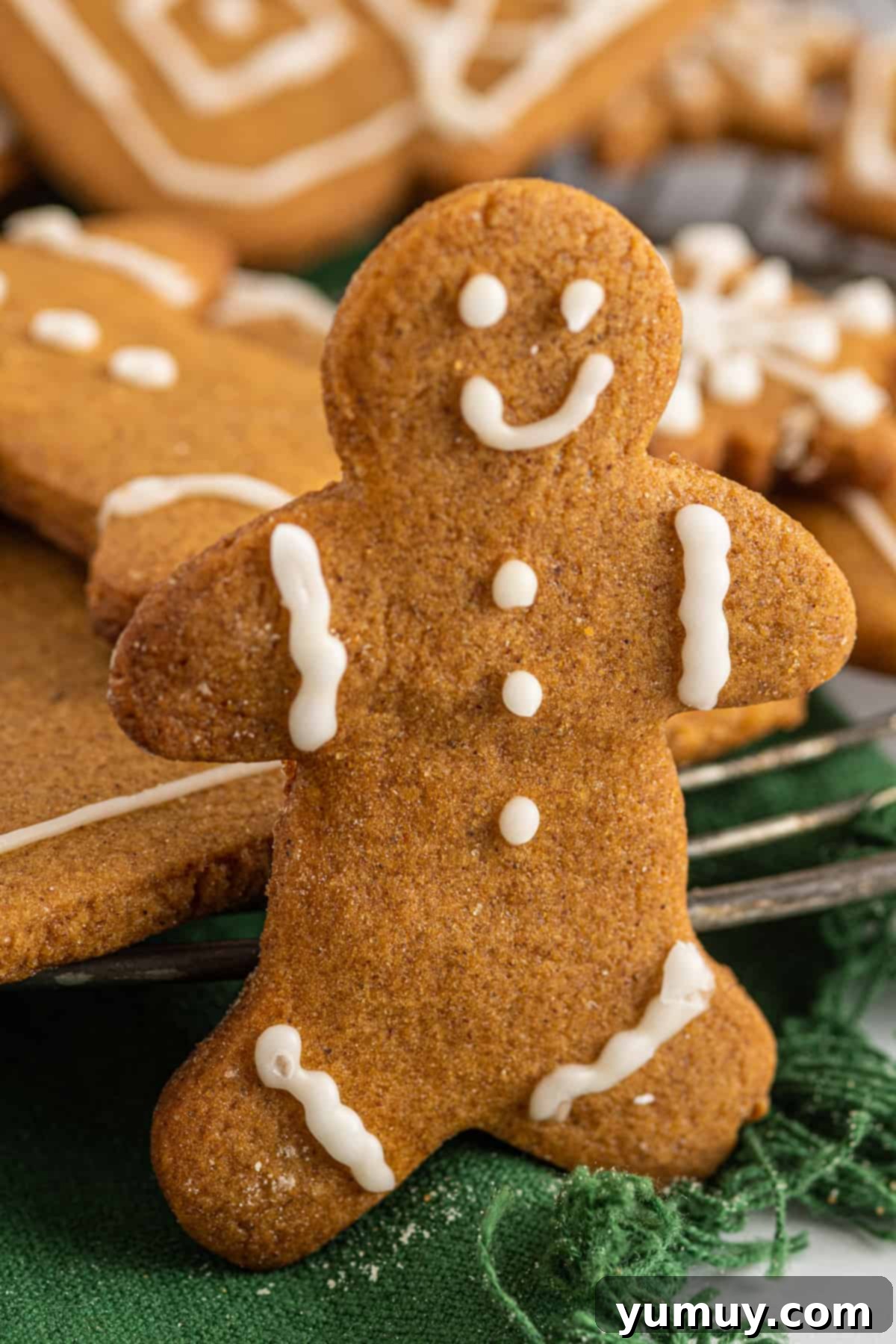

Classic Iced Gingerbread Cookies Recipe
These classic iced gingerbread cookies are a holiday essential! Infused with warm spices and rich molasses, they bake up perfectly with crisp edges and a soft, chewy interior. This no-spread recipe is ideal for creating beautifully shaped cut-out cookies that are perfect for decorating with royal icing or assembling into a festive gingerbread house. A true taste of holiday magic!
Prep Time: 1 hour 15 minutes
Cook Time: 10 minutes
Total Time: 2 hours 25 minutes
Chill Time: 1 hour
Yields: 60 cookies
Print Recipe
Ingredients
For the Gingerbread Cookies:
- 2⅔ cups all-purpose flour
- 2 teaspoons ground ginger
- 1½ teaspoons ground cinnamon
- 1 teaspoon baking powder
- ½ teaspoon ground nutmeg
- ¼ teaspoon ground cloves (optional, but highly recommended for depth)
- 10 tablespoons salted butter, softened to room temperature (1¼ sticks)
- ¾ cup brown sugar, packed
- ¼ cup granulated sugar
- ⅔ cup unsulphured molasses (*See notes for type)
- 1 large egg
- 1 large egg yolk
- 1½ teaspoons pure vanilla extract (optional, but adds great flavor)
For the Royal Icing (Optional):
- 1 cup powdered sugar, sifted
- 1 tablespoon milk (dairy or non-dairy)
- 1½ teaspoons light corn syrup (**See notes for substitutions)
Equipment
- Kitchen Scale (optional, for precise flour measurement)
- Stand Mixer with paddle attachment
- 2 Baking Sheets
- Parchment Paper
- Rolling Pin
- Assorted Cookie Cutters (2-inch recommended)
- Piping Bag (for icing)
Instructions
Combine Dry Ingredients: In a medium-sized bowl, thoroughly whisk together the all-purpose flour, ground ginger, ground cinnamon, baking powder, ground nutmeg, and ground cloves. Ensure there are no clumps, then set this dry mixture aside.

Cream Butter and Sugars: In the bowl of a stand mixer fitted with the paddle attachment, beat the softened salted butter, brown sugar, and granulated sugar together on medium-high speed. Continue beating for about 2 minutes, until the mixture is light, fluffy, and noticeably lighter in color. This process incorporates air, crucial for cookie texture. Remember to scrape down the sides of the bowl as needed to ensure everything is well combined.

Incorporate Wet Ingredients: Add the molasses, large egg, egg yolk, and pure vanilla extract to the creamed butter mixture. Beat for another minute on medium speed until all ingredients are fully incorporated and the mixture appears smooth and cohesive. Again, scrape down the bowl to ensure no unmixed pockets remain, creating a uniform base for the dough.

Add Dry Ingredients: Gradually add the whisked flour mixture to the wet ingredients in the stand mixer. Mix on low speed just until combined, approximately 45 seconds. It is critical not to overmix at this stage, as excessive mixing develops gluten, which can lead to tough, rather than tender, cookies.

Chill the Dough: Remove the gingerbread cookie dough from the mixing bowl. Gently shape it into a flat disc, then wrap it tightly in plastic wrap, ensuring no air pockets. Place the wrapped dough in the refrigerator to chill for at least 1 hour. Chilling is an essential step that firms up the butter, prevents the cookies from spreading excessively during baking, and makes the dough much easier to handle, roll, and cut. For best results and easier handling, you can chill it overnight.

Prepare for Baking: Once the dough has thoroughly chilled, remove it from the refrigerator. Preheat your oven to 350°F (175°C). Line two large baking sheets with parchment paper, which prevents sticking and ensures even baking, and set them aside. If your dough feels too firm or brittle to roll out immediately, allow it to sit at room temperature for 5-10 minutes to soften slightly.

Roll and Cut Cookies: Lightly flour a clean, flat work surface (like a countertop or large pastry board). Unwrap the cookie dough and place it onto the floured surface. Using a rolling pin, roll the dough out evenly to a consistent thickness of about ¼-inch. Use your favorite assorted cookie cutters (e.g., classic gingerbread men, festive stars, Christmas trees, etc.) to cut out shapes from the dough. Carefully transfer the cut-out cookies to the prepared baking sheets, placing them about ½-inch apart to allow for minimal expansion.
Bake: Place the baking sheets into the preheated oven and bake for 8-9 minutes. The precise baking time may vary slightly depending on your oven and cookie thickness. The cookies will be slightly soft to the touch when you remove them from the oven, but their edges will appear firm and set. This is perfectly normal; they will continue to firm up further as they cool. Avoid overbaking, as this will result in dry, brittle cookies rather than delightfully chewy ones.

Repeat & Cool: While the first batch bakes, gather the remaining dough scraps. Gently form them into a ball (avoid overworking) and roll them out again to cut more cookies. Continue this process until all the dough is used. Once baked, remove the cookies from the oven and carefully transfer them (a thin spatula is helpful) to a wire cooling rack to cool completely. This allows air to circulate, preventing sogginess and ensuring a crisp texture. Ensure they are fully cooled before decorating.

For the Royal Icing:
Prepare Icing: While the cookies are cooling, prepare the optional royal icing. In a medium-sized bowl, whisk together the sifted powdered sugar, light corn syrup, and milk. Continue whisking vigorously for several minutes until the mixture is completely smooth and reaches a toothpaste-like consistency. It should be thick enough to hold its shape when lifted but still flow smoothly off the whisk. Be patient, as this may require dedicated whisking time.

Fill Piping Bag: Carefully spoon the prepared royal icing into a sturdy piping bag. To prepare for decorating, snip a very small hole (approximately the size of a pinhead) at the very tip of the piping bag. This small opening is ideal for precise detailing and fine lines. Ensure the opening is not too large initially, as you can always make it bigger if needed.

Decorate & Set: Ice the completely cooled gingerbread cookies as desired, creating intricate patterns, simple outlines, or festive flood fills. Once decorated, allow the cookies to sit undisturbed on a flat surface for at least 15 minutes, or until the royal icing has hardened completely. This prevents smudging and allows for stacking.

Notes
- *Molasses Choice: For the most authentic and delicious gingerbread flavor, always opt for dark unsulphured molasses. Blackstrap molasses, while often available, is significantly stronger and can impart an overpowering, slightly bitter taste that will detract from your cookies.
- **Corn Syrup in Icing: Light corn syrup is included in the royal icing recipe for a specific purpose: it adds a beautiful, glossy shine to the finished icing and helps to prevent crystallization, resulting in a smoother, more professional-looking finish. If you prefer to avoid corn syrup, you can substitute it with an equal amount of honey, maple syrup, or agave nectar. However, be aware that these alternatives may subtly alter the color and flavor of your icing.
Additional Tips for Success:
- Creaming Butter & Sugar: The key to a tender cookie is properly creamed butter and sugar. Ensure your butter is truly at room temperature (soft enough to indent with a finger, but not melted). Cream it with the sugars until the mixture is noticeably pale and fluffy; this indicates ample air has been incorporated, leading to a lighter, more delicate cookie. Don’t forget to pause and scrape down the sides of the bowl frequently to ensure everything is evenly mixed.
- Avoiding Tough Cookies: Once you add the flour mixture to the wet ingredients, mix the dough only until the flour streaks have just disappeared and it forms a cohesive mass. Overmixing develops gluten, which can make your gingerbread cookies tough and less pleasant to eat. Stop the mixer as soon as the ingredients are combined.
- Dough Consistency Adjustments: If, after chilling, your dough feels too firm or cracks excessively when you begin rolling, let it warm up at room temperature for 5-10 minutes to soften slightly. Conversely, if the dough feels too soft, sticky, or greasy to handle, pop it back into the fridge for an additional 10-15 minutes until it firms up.
- Handling Cut-Outs with Care: Gingerbread dough can be delicate once cut. Use a thin, wide spatula, a butter knife, or a bench scraper to gently lift cut-out cookie shapes from your floured surface to the baking sheet. This technique prevents stretching, tearing, or deforming your perfectly shaped cookies.
- Icing Consistency for Piping: When whisking royal icing, if it seems too thick for piping, add milk a tiny drop at a time (start with ½ teaspoon increments) until it reaches the desired flow. If it becomes too thin, gradually add more sifted powdered sugar. The “toothpaste” consistency mentioned is ideal for outlining and creating intricate details, while a slightly thinner “flood” consistency (like honey) is used for filling in large areas.
- Optimal Piping Technique: To achieve clean lines and decorations, hold the piping bag almost at a 90-degree angle to the cookie, with the tip suspended about ⅛-inch away from the surface. Apply gentle, consistent pressure to the bag and allow the icing to fall onto the cookie surface, rather than dragging the tip directly on the cookie. This creates smoother, more professional-looking lines.
Make-Ahead Instructions:
You can prepare the gingerbread cookie dough well in advance, making holiday baking much less stressful! Simply prepare the dough as instructed up to the chilling step. Wrap the dough tightly in at least two layers of plastic wrap, ensuring it’s airtight, and then seal it in a freezer-safe zip-top bag. Store the dough in the freezer for up to 3 months. When you’re ready to bake, transfer the frozen dough to the refrigerator and allow it to thaw overnight. Once thawed, proceed with rolling out and baking the cookies as per the recipe instructions.
Storage Instructions:
Baked gingerbread cookies will stay wonderfully fresh in an airtight container at room temperature for up to 3 days. For extended freshness, they can be stored in the refrigerator for up to 1 week, or frozen for up to 1 month. Always ensure any icing or decorations are completely hardened before storing or stacking to prevent sticking and damage.
Nutrition Facts
Iced Gingerbread Cookies Recipe
Amount Per Serving (1 cookie)
Calories 73
Calories from Fat 18
% Daily Value*
Fat 2g 3%
- Saturated Fat 1g 6%
- Trans Fat 0.1g
- Polyunsaturated Fat 0.1g
- Monounsaturated Fat 1g
Cholesterol 11mg 4%
Sodium 26mg 1%
Potassium 68mg 2%
Carbohydrates 13g 4%
- Fiber 0.2g 1%
- Sugar 8g 9%
Protein 1g 2%
Vitamin A 67IU 1%
Vitamin C 0.003mg 0%
Calcium 17mg 2%
Iron 1mg 6%
* Percent Daily Values are based on a 2000 calorie diet.
Author: Becky Hardin
Did You Make This?
We love seeing what you’ve made! Tag us on social media at @easydessertrecipes for a chance to be featured.
More Delightful Cookie Recipes to Try!
Irresistible Butter Cookies
Decadent Brownie Mix Crinkle Cookies
Scrumptious Churro Cookies
Delightful Chocolate Pudding Cookies
Browse All Cookie Recipes
